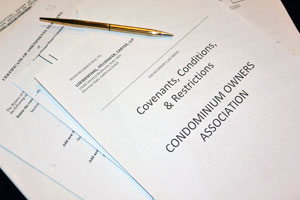Wittenberg v. Beachwalk Homeowners Association (2013) 217 Cal. App. 41h654.
Facts:
The Association held an election to amend its CCRs and the plaintiffs filed a lawsuit to void the result of the election on the ground that the Association’s board violated Civil Code Section 1363.03 (a)(1) and (a)(2) concerning use of “association media” to campaign for the amendment but refused to give equal access to members who opposed the amendment. The amendment was designed to eliminate a 2/3 approval requirement in the CCRs to make alterations, additions or improvements to the common areas of the development which cost more than $1,000.00. The Board was sued because it allegedly had removed one swimming pool without a vote of the membership.
Realizing that the burden of a 273 vote of the membership was very onerous, the Board advocated an amendment that provided the Board with much greater flexibility and discretion in making expenditures for capital improvements to the common areas. The Board sent out ballots and encouraged the members to vote for the amendment. Accompanying the Jetter and ballots was a one-page attachment which was also prepared by the Board which was essentially a “pros and cons” of the amendment. The “cons” section of the attachment was derived from open forum comments of members at meetings. However, the Board specifically declined to include any written opposition material. In addition, the Board refused to Jet the opposition use the Association clubhouse for free to hold a “town meeting” to discuss the amendment and the board up for election.
Two elections conducted by the Association at substantial expense failed to garner the requisite 75% supermajority to adopt the amendment. During these elections the Board continued to use the Association’s newsletter to lobby for positive votes but opposing views were not invited to submit any materials. In response to one such article in favor of the amendment, a member asked to write a response to be published in the newsletter. The Board refused because only directors were permitted to publish articles. The Boq,rd posted materials in favor of the amendment on the Association website and in display cases but did not allow non-board members to post opposing materials. The Board also advised the membership that it would continue to seek to have the amendment passed by sending out ballots (at $5,000 per election) until the 51% threshold was reached.
The Association never reached the 75% approval, but did reach the majority threshold which would allow it to file a Petition To Reduce Voting Percentage in the Superior Court as allowed by Civil Code Section 1356. The Plaintiffs filed this lawsuit to invalidate the election and prevent the approval of the amendment through the Petition process.
At trial, the court ruled that the provisions of Section 1363.03 requiring equal access to association media made a distinction between access to candidates and members advocacy and the “Association” and ruled that there was no violation of the statute requiring equal access.
Appellate Decision:
Not surprisingly, the appellate court reversed the trial court’s decision and ruled that the trial court erred in finding that the Association did not have to provide equal access to Association media when the Association’s board was the one advocating for a position such as on the proposed amendment. The appellate court found that Section 1363.03 (a)(1) cannot be interpreted to allow Board members, who are also Association members, to advocate for a particular point of view in an election, without giving equal access to members with opposing views. The appellate court also found that the Association violated Section 1363.03 (a)(2) in denying free access to use Association common areas, including the clubhouse and a greenbelt, to hold meetings at which the amendment was to be discussed by opponents to the amendment.
Significance:
Associations and their Boards have to be very careful to avoid preventing opposing views to be expressed through Association media sources on any issue that is being put to the vote of the membership, including changes to governing documents, special assessments or elections of directors. In addition, it clarifies that Boards can be characterized as advocates that can trigger the right to use Association media by opponents. This case is a classic example of a Board being so heavy handed in trying to both coerce the membership to approve the action and prevent the opposition from having a voice that the court could not come to any other conclusion.
Friars Village Homeowners Association v. Charles I. Hansing (2013) 220 Cal. App. 41h 405.
Facts:
The Association’s Board of Directors adopted an operating rule as part of its election policy which prevents a person from running for the Board if the prospective candidate is related by blood or marriage to any current Board member or to any current candidate for such office. Mr. Hansing sought to nominate himself to run for the Board during a period of time when his wife, was currently serving on the Board. Mr. Hansing challenged the legality of this rule on the basis that it violated Civil Code Section 1363.03, which guarantees the right of every member to nominate himself or herself to run for the Board. After his self-nomination was rejected, he filed suit to have the rule declared invalid.
The Board’s rationale for the rule was to prevent possible wrongdoing by two directors from the same household and to prevent a situation in which two members would constitute a substantial voting block within the nine member board.
In a court trial, a judgment was issued in favor of the Association that the rule was properly adopted, was valid and may be enforced.
Appellate Decision:
On appeal, the court went through an analysis of numerous appellate decision which discussed that individual expectations in a common interest development setting had to be tempered by the fact that possibility that the Association would pass a rule or policy that an individual may disagree with. The issues on appeal were: (1) was the election rule preventing related persons running for the board or serving on the board at the same time reasonable; and (2) was it inconsistent with the Association’s governing documents and current law. The court discussed the relative deference given to Board decisions and the need for the purpose of the rule to be rationally related to the protection, preservation and proper operation of the property and purposes of the Association set forth in the Association’s governing documents.
The appellate court ruled that the election rule prohibiting relatives from running or serving on the Board to be a valid and enforceable operating rule setting the qualifications of a director pursuant to Section 1363.03. The court held that the rule was rationally related to the protection, preservation and proper operation of the Association and that it was not unfair or discriminatory. The court stated: “the record supports a conclusion that the relationship rule was a legitimate response to business concerns among Association members that allowing a voting bloc on the Board would not be in the best interests of the Association. The Board’s policy decision to enact the relationship rule constitutes a reasonable attempt to balance the respective interests, and is consistent with the nature of the specific requirements in the governing documents and other rules…. Such requirements legitimately promote the ability of the Board members to impartially conduct the business affairs of the development.”
Significance:
This decision is significant because it does not give blind credence to the provision in Section 1363.03 concerning the right to self-nominate in lieu of a broader analysis of the rule in light of the best interests of the Association and whether it is discriminatory or unfair. Consequently, this seems to be another in a string of appellate decisions which analyzes Association rules and issues pragmatically and equitably rather than narrowly interpreting a code section without important context.
Arlyne M. Diamond v. Superior Court (2013) 217 Cal. App. 41h 1172
Facts:
In 2006, the members of the Casa Del Valle Homeowners Association passed a special assessment to pay for a roofing replacement project in the sum of $9,750 per unit. Diamond was unable to pay the lump sum special assessments and attempted to negotiate a payment plan with the Association. Diamond believed that she had reached an agreement with the Board president for a payment plan which involved payment of $1000 down and $100 per month until her financial situation improved. She also believed that this agreement was to be memorialized in a promissory note that she would execute. After making the down payment and five monthly payments of $100, she received a “pre-lien” letter from the Association’s attorney, alleging that the total amount due was over $10,000 and threatening to record an assessment lien if not paid within 30 days. The letter contained the various notice provisions relative to member rights to engage in dispute resolution and to review association records. Diamond responded to the pre-lien letter with a letter to the attorney explaining about the payment plan agreed to by the Association’s president and stated that she was in compliance with the agreement. The Association then proceeded to record the assessment lien and provided her with a copy of the recorded lien. The cover letter enclosing the recorded lien indicated that the Board had approved a 12 month payment plan that consisted of monthly payments of $989.17 and the maintenance of the lien until the balance was paid in full.
Diamond hired an attorney who wrote the Association’s attorney and requested that the parties meet and confer and if unsuccessful, engage in alternative dispute resolution. The Board rejected both the meet and confer and ADR requested, stating that the Board had already met and conferred and she wasn’t entitled to both. The Board also returned three $100 checks which Diamond had submitted after the lien was recorded. Thereafter, the Board met in executive session and approved commencement of a foreclosure proceeding through a judicial foreclosure.
Diamond file a motion for summary judgment and motion to expunge the lien based on the Association’s multiple failures to strictly follow the procedures and notice provisions set forth in Civil Code Section 1367.1 which are mandated prerequisites to recording a lien and pursuing foreclosure. The trial court denied these motions on the basis that Diamond failed to meet her burden to produce evidence that the Association is barred by Civil Code Section 1367.1 and 1367.4 and that the Association had “substantially complied” with the statutory requirements.
Appellate Decision:
Diamond appealed the denial of the motions. The appellate court went through a painstaking analysis of the statutory requirements of Section 1367.1 and the legislative history in determining that the Association had failed to strictly comply with the statutory notice and related requirements and in ruling that “substantial compliance” was not adequate when a member could lose her home to foreclosure, based on the clear statutory language and legislative history. The court found multiple technical failures by the Association to strictly comply with the statutory notice requirements in the pre-lien letter, a failure to properly document in Association minutes the decision to foreclose and the failure to personally serve the notice of intent to foreclose on Diamond, each of which made the assessment lien invalid. The appellate court ordered the trial court to grant the summary judgment in Diamond’s favor and expunge the lien.
Significance:
This case is significant because it establishes that every “i” needs to be dotted and every “t” needs to be crossed in complying with the statutory requirements related to collections and lien foreclosures. One technical mistake related to the procedures in the statute will result in the lien being invalid and forcing the Association to start over and potentially, being responsible for the attorney’s fees and costs of the member who successfully challenges the collection process. This strongly underscores that a highly regimented and professional approach to collection activities must be maintained by Associations, management companies, attorneys and foreclosure trustees to be able to document clearly that every statutory requirement was met, right down to inclusion of the execute session action approving foreclosure in the minutes of the next regular board meeting.
Liberty Mutual Insurance Company v. Brookfield Crystal Cove LLC 219 Cal. App. 41h 98.
Facts:
Eric Hart purchased a newly constructed home from the defendant developer. A pipe in the fire sprinkler system burst, causing significant damage. Hart’s property insurer, Liberty Mutual, paid his relocation expenses while Hart was out of the home during repairs. Liberty Mutual sued the defendant developer in subrogation to recover those relocation expenses. The defendant argued and the trial court agreed, that the claim was time-barred under the Right to Repair Act (Civil Code Section 895 et seq.) because the case was filed more than four years after the purchase. Under the Right to Repair Act, a plaintiff’s burden is to demonstrate a defective condition exists, without any requirement of physical property damage caused by the defect. This act was put into play to address a Supreme Court decision that precluded claims against contractors and subcontractors based on a negligence theory for defective construction in the absence of property damage caused by the negligent construction. (Aas)
Appellate Decision:
Liberty Mutual appealed the trial court’s decision on the basis that there is no language in the Right to Repair Act making it the exclusive remedy for construction defects when there is actual property damage caused by the defective condition. The appellate court agreed, ruling that the shorter statutes of limitation in the Right to Repair Act do not apply to claims for actual property damage arising from a construction defect and instead, the general statutes of limitation for latent defects (10 years) and patent defects (4 years from discovery) and for property damage·(3 years after damage) applied.
Significance:
Developers, contractors and subcontractors have attempted to argue that all aspects of construction defect litigation are controlled by the Right to Repair Act, including the narrow and restrictive statutes of limitation for various types of defective construction. This case brings back into play defective construction claims which are undiscovered and manifest property damage after the short limitations in the Right to Repair Act have run.
Fowler v. M & C Association Management Services, Inc. (2013) 220 Cal. App. 4th 1152.
Facts:
Fowler was the lead plaintiff in a potential class action lawsuit against a management company for charging “transfer fees” in order to update homeowner records. The plaintiff claimed that unless the management company filed a notice of the transfer fee with the Office of the County Recorder pursuant to Civil Code Section 1098. That section requires the recording a notice of certain types of transfer fees before such fees can be collected.
Appellate Decision:
The Court of Appeals ruled that transfer fees charged by management companies were exempt from this requirement due to an exemption in Section 1098 for any “transaction authorized by the Davis-Stirling Common Interest Development Act.” The basis for the decision was an expansion of the principles in the prior decisions of Berryman v. Merit Property Management, Inc. and Brown v. Professional Community Management, Inc. which dealt with whether fees charged by management companies to Associations per the management contract could be passed through to members in sales transactions without proof that the amount charged by management the actual amount it cost the manager to perform. In those decisions the courts found that the management company’s fee was a contractual issue with the Association and not subject to the actual cost requirement of Civil Code Section 1366.1.
Significance:
The trend continues at the appellate court level of not micro-managing the contractual relationship between associations and management companies and treating management companies as a mere extension of the Board that is subject to the restraints and limitations of the laws applicable to associations. This decision recognizes that Boards are entitled to enter contracts with managers to perform certain association functions and that commercial transaction is entitled to deference by the courts.


